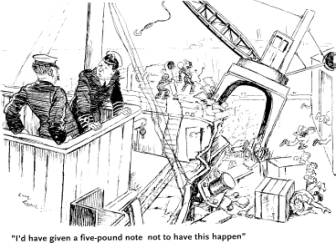
Demolition of a Crane -- The importance of Master / Pilot Exchange

| The incident |
| A 10,000 GT general cargo ship was approaching a berth in a European port on a winter evening. The ship hit a gantry crane which collapsed. Damage was also caused to the quay and there was minor damage to the ship. |
|
Let this not happen to you What happened? |
|
The ship was under pilotage and approaching the berth, to berth starboard side to, with the assistance of tugs. Visibility was good and there was a light onshore wind. The chief officer and three seamen were forward, the second officer and three seaman aft, and the master, pilot, third officer and a helmsman were on the bridge. The forward tug was made fast with a tugs line from the centre lead and the aft tug with a tugs line from the port quarter.
As the ship approached the berth at an angle of about 30°, the master and pilot failed to realise that the bow was too close to a gantry crane at the end of the berth. The flare of the bow on the starboard side passed over the edge of the quay and pushed the leg of the gantry crane. This caused the crane to twist and the structure collapsed.
Although the damage to the ship was relatively minor, the damage to the crane and berth, and the loss of use of the berth, cost several million US dollars. |
| What went wrong? |
|
The ship approached the berth in such a way that the flare of the bow hit the gantry.
Subsequent investigation showed that the berth and the gantry had not been very well lit. There had been communications difficulties between the pilot and the dock master, with the result that the pilot was not sure of the required berthing position of the ship or the position of the gantry cranes. There had been no communications between the master and the chief officer on the focs¡¦le as to the distance of the ship from the quay. |
| What can we learn from this incident? |
|
Good communications and exchange of information when planning ship movements are essential. The master and pilot should have exchanged information and agreed a berthing plan which would have included the above information and taken into account the position of obstructions such as the gantry crane. The master should have informed the pilot of ship characteristics such as the bow flare.
The port authorities should have ensured that the berth was well lit and that the pilot and ship were fully informed of the berthing requirements and position of obstructions. All obstructions such as gantries and cranes should be moved out of the way or to a position amidships clear of danger from an over hanging part of the ship's bow or stern.
If necessary, berthing should have been delayed until the gantry crane had been moved to a less vulnerable position.
The chief officer should have been observing the situation and informing the master of the existence of the poorly lit gantry and of the distance of the bow from the quay. As the distance decreased he should have made certain that the master was fully aware of the situation so that avoiding action could have been taken. |
"Remember to Prepare your passage plan from Pilot station to berth."
|
Published by: Fleet
Management Limited Phone: 852 2861 3511 Fax: 852 2528 1550 Email: fml@fleetship.com |
"The
Bottom Line" Murphy's
Maritime Law
|